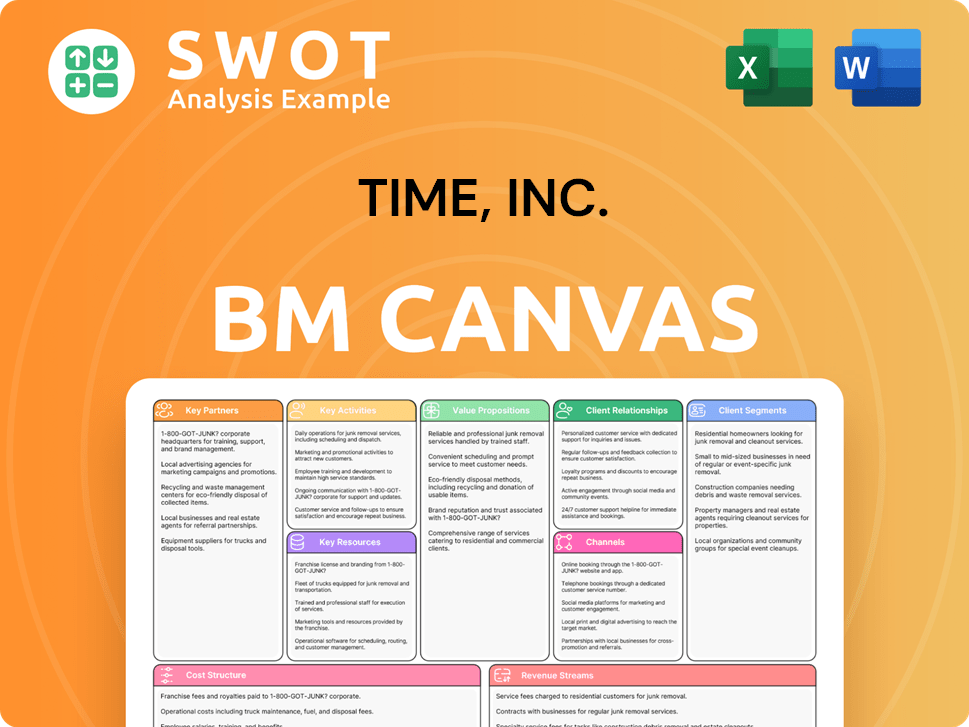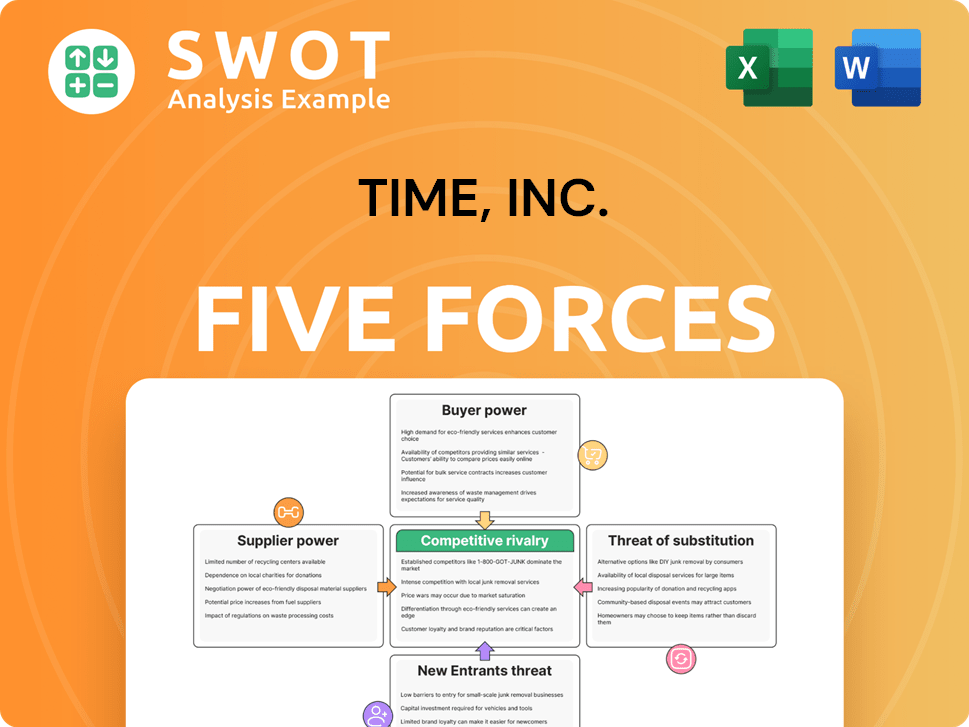Time, Inc. Bundle
Who Really Owns Time Inc. Today?
Unraveling the ownership of Time Inc. is essential for understanding the evolution of a media giant. From its inception in 1922, Time Inc. shaped the news landscape with publications like Time magazine, becoming a cornerstone of American journalism. Knowing its Time, Inc. SWOT Analysis is important for investors. This exploration dives into the corporate structure and the pivotal moments that defined its trajectory.

The journey of Time Inc. ownership reveals a fascinating narrative of media consolidation and strategic shifts. Initially a private entity, it transformed into a publicly traded company before being acquired by Meredith Corporation. Understanding the parent company and the history of Time Inc. ownership provides crucial insights into its current operations and future prospects. This analysis considers key questions like "Who purchased Time Inc.?" and "Who controls Time magazine now?" to offer a comprehensive view of this media conglomerate.
Who Founded Time, Inc.?
The genesis of Time Inc., a media powerhouse, traces back to 1922. It was founded by Henry R. Luce and Briton Hadden, both graduates of Yale University, who envisioned a new approach to journalism.
Their initial funding was modest, approximately $100,000, gathered from a network of investors, including classmates and friends. This initial capital injection was crucial in launching Time magazine, the cornerstone of their media venture.
While precise equity splits at the outset are not widely available, Luce and Hadden were the driving forces, holding substantial control over the editorial and business strategies. Early investors were primarily individuals who believed in the founders' innovative concept for a weekly news magazine.
The early ownership structure was designed to ensure editorial independence and control by the founders. Agreements likely included provisions to safeguard the long-term vision of Luce and Hadden.
- The distribution of control was heavily concentrated with Luce.
- He remained a dominant figure as the company expanded into other publications.
- The expansion included titles like Fortune, Life, and Sports Illustrated.
- This reflected his enduring vision for a multifaceted media empire.
Time, Inc. SWOT Analysis
- Complete SWOT Breakdown
- Fully Customizable
- Editable in Excel & Word
- Professional Formatting
- Investor-Ready Format

How Has Time, Inc.’s Ownership Changed Over Time?
The history of Time Inc. regarding its Time Inc. ownership is marked by significant shifts in its corporate structure. Initially an independent entity, it became part of a larger media conglomerate when it merged with Warner Communications in 1990 to form Time Warner Inc. This integration meant that Time Inc. was owned by the shareholders of Time Warner, which included a mix of institutional and individual investors.
A key moment was the spin-off from Time Warner on June 6, 2014, which allowed Time Inc. to become an independent, publicly traded company again. At that time, major shareholders were primarily institutional investors such as Vanguard Group Inc., BlackRock Inc., and State Street Corp., holding a substantial portion of the company's stock. These institutional investors played a crucial role in the company's strategy through their voting power.
| Event | Date | Impact on Ownership |
|---|---|---|
| Merger with Warner Communications | 1990 | Became part of Time Warner Inc., owned by Time Warner shareholders. |
| Spin-off from Time Warner | June 6, 2014 | Became an independent, publicly traded company. |
| Acquisition by Meredith Corporation | January 2018 | Ceased to exist as a separate public entity; assets transferred to Meredith Corporation shareholders. |
The most transformative event was the acquisition of Time Inc. by Meredith Corporation in January 2018 for $2.8 billion. This acquisition, partly financed by a $650 million equity investment from Koch Equity Development LLC, resulted in Time Inc. no longer being a publicly traded company. The ownership of Time magazine and other assets shifted to Meredith Corporation's shareholders, including the Koch brothers through their investment. This acquisition led to changes in strategy, including consolidations and divestitures within the combined media portfolio.
The ownership of Time Inc. has seen significant changes over the years, from being an independent entity to part of a major media conglomerate and back to independence before its acquisition. The acquisition by Meredith Corporation in 2018 marked a significant shift, integrating Time Inc. into a new corporate structure.
- Merger with Warner Communications in 1990 created Time Warner Inc.
- Spin-off in 2014 made Time Inc. an independent, publicly traded company.
- Acquisition by Meredith Corporation in 2018 changed the ownership structure again.
- Koch Equity Development LLC provided a significant equity investment for the acquisition.
Time, Inc. PESTLE Analysis
- Covers All 6 PESTLE Categories
- No Research Needed – Save Hours of Work
- Built by Experts, Trusted by Consultants
- Instant Download, Ready to Use
- 100% Editable, Fully Customizable

Who Sits on Time, Inc.’s Board?
Prior to its acquisition, Time Inc., as a publicly traded entity, operated under the oversight of a board of directors. This board comprised a mix of independent and executive directors, including the CEO. The composition of the board reflected various professional backgrounds. However, specific details regarding the board's composition immediately before the acquisition by Meredith Corporation in 2018 are not readily available in public summaries from 2024-2025. The board's primary function was to ensure effective governance and strategic direction for the media conglomerate.
The voting structure for Time Inc. followed a standard one-share-one-vote principle, typical for U.S. publicly traded corporations. There's no public record of dual-class shares or special voting rights that would have granted outsized control to specific entities before the acquisition. The decision to sell to Meredith Corporation was driven by strategic considerations and shareholder value, rather than a proxy battle for board control. Post-acquisition, governance shifted to Meredith Corporation's board, focusing on integrating the acquired brands.
| Board Member | Title | Affiliation |
|---|---|---|
| Stephen Lacy | Chairman of the Board | Meredith Corporation (Former) |
| Tom Harty | President and CEO | Meredith Corporation (Former) |
| John Zieser | Executive Vice President, Chief Financial Officer and Treasurer | Meredith Corporation (Former) |
The acquisition of Time Inc. by Meredith Corporation in 2018 significantly altered the corporate structure. The governance of the former Time Inc. assets now falls under the purview of Meredith Corporation's board of directors. This shift has led to a focus on integrating the acquired brands and realizing synergies within the larger media conglomerate. The latest news indicates that the focus is on streamlining operations and maximizing the value of the combined portfolio of assets, including Time magazine.
Meredith Corporation acquired Time Inc. in 2018, changing the ownership structure. The board of directors now oversees the former Time Inc. assets.
- Meredith Corporation's board now governs the assets.
- The focus is on integrating brands and realizing synergies.
- The acquisition was a strategic move to enhance shareholder value.
- The voting structure followed a standard one-share-one-vote principle.
Time, Inc. Business Model Canvas
- Complete 9-Block Business Model Canvas
- Effortlessly Communicate Your Business Strategy
- Investor-Ready BMC Format
- 100% Editable and Customizable
- Clear and Structured Layout

What Recent Changes Have Shaped Time, Inc.’s Ownership Landscape?
The most significant recent development concerning Time Inc.'s ownership profile was its acquisition by Meredith Corporation in January 2018. This event fundamentally altered Time Inc.'s independent existence and its ownership structure. Post-acquisition, Time Inc. ceased to be a standalone entity, and its various magazine titles and digital properties were integrated into Meredith's portfolio. This led to significant changes, including divestitures of certain Time Inc. brands.
For example, Meredith sold Time magazine to Marc Benioff, co-founder of Salesforce, and his wife Lynne Benioff, in September 2018 for $190 million. Fortune magazine was sold to Chatchaval Jiaravanon in 2019 for $150 million. Sports Illustrated was licensed to Authentic Brands Group in 2019 for a reported $110 million, with Meredith retaining the publishing rights for a period. These divestitures reflect a broader industry trend of media consolidation and the strategic realignment of portfolios.
Meredith Corporation acquired Time Inc. in January 2018, changing its ownership. Several brands were sold off post-acquisition. These sales reflect media industry trends of consolidation and strategic shifts.
Time magazine was sold to Marc Benioff for $190 million. Fortune magazine was sold to Chatchaval Jiaravanon for $150 million. Sports Illustrated was licensed to Authentic Brands Group for $110 million.
Time, Inc. Porter's Five Forces Analysis
- Covers All 5 Competitive Forces in Detail
- Structured for Consultants, Students, and Founders
- 100% Editable in Microsoft Word & Excel
- Instant Digital Download – Use Immediately
- Compatible with Mac & PC – Fully Unlocked

Related Blogs
- What are Mission Vision & Core Values of Time, Inc. Company?
- What is Competitive Landscape of Time, Inc. Company?
- What is Growth Strategy and Future Prospects of Time, Inc. Company?
- How Does Time, Inc. Company Work?
- What is Sales and Marketing Strategy of Time, Inc. Company?
- What is Brief History of Time, Inc. Company?
- What is Customer Demographics and Target Market of Time, Inc. Company?
Disclaimer
All information, articles, and product details provided on this website are for general informational and educational purposes only. We do not claim any ownership over, nor do we intend to infringe upon, any trademarks, copyrights, logos, brand names, or other intellectual property mentioned or depicted on this site. Such intellectual property remains the property of its respective owners, and any references here are made solely for identification or informational purposes, without implying any affiliation, endorsement, or partnership.
We make no representations or warranties, express or implied, regarding the accuracy, completeness, or suitability of any content or products presented. Nothing on this website should be construed as legal, tax, investment, financial, medical, or other professional advice. In addition, no part of this site—including articles or product references—constitutes a solicitation, recommendation, endorsement, advertisement, or offer to buy or sell any securities, franchises, or other financial instruments, particularly in jurisdictions where such activity would be unlawful.
All content is of a general nature and may not address the specific circumstances of any individual or entity. It is not a substitute for professional advice or services. Any actions you take based on the information provided here are strictly at your own risk. You accept full responsibility for any decisions or outcomes arising from your use of this website and agree to release us from any liability in connection with your use of, or reliance upon, the content or products found herein.